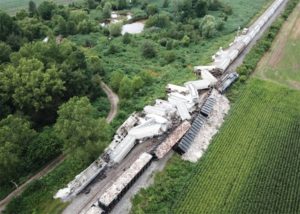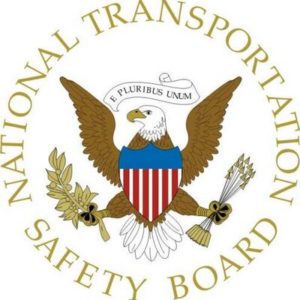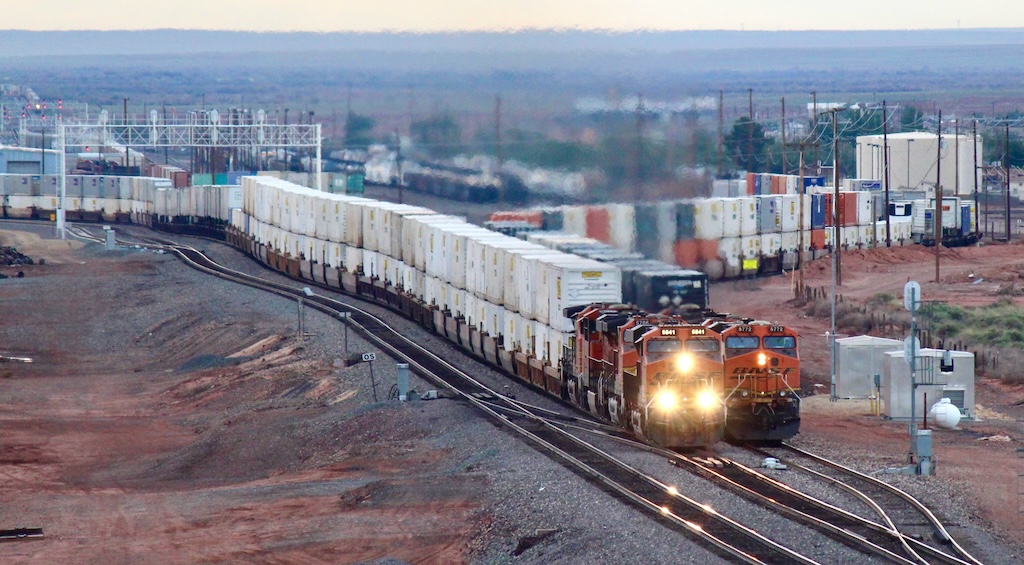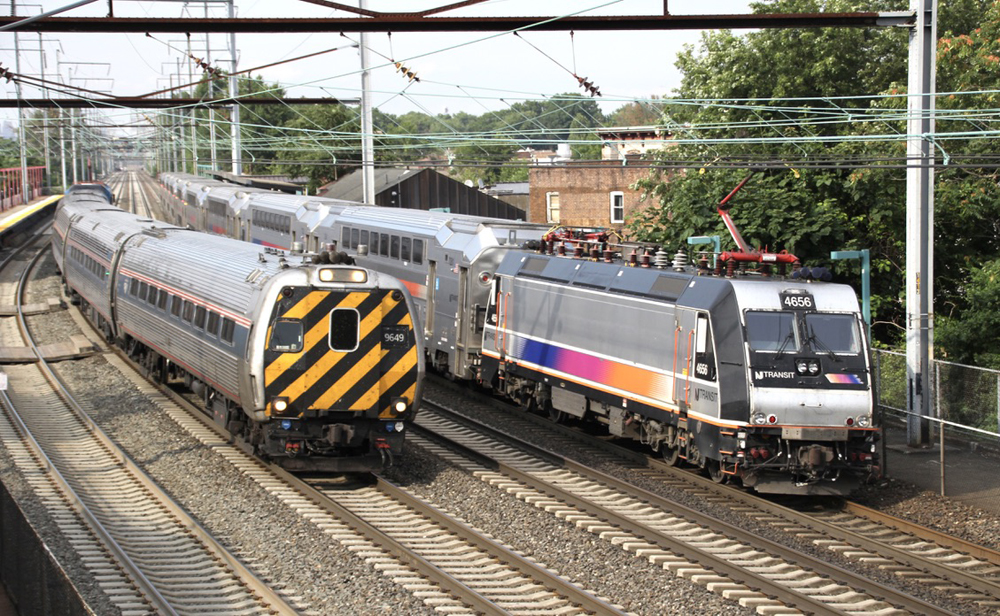
The probable cause of the Aug. 12 collision, the board found, was the engineer’s alcohol impairment. A contributing factor: The design of the positive train control system, which does not prevent collisions when it is set in the restricted mode that permits switching moves.
Westbound local train H702, which rammed into eastbound 110-car frac sand train W314 at a control point, was operating with its PTC system in restricted mode at the time of the 5:08 a.m. collision in Carey, which is between Columbus and Fostoria.
Prior to the crash, which caused minor injuries to both engineers, H702’s crew had stopped at Carey to set out 30 empty cars. To accomplish the shove moves in active PTC territory, the engineer put the locomotive’s PTC into restricted mode, which protects against overspeed events but does not automatically stop a train before it can violate a red signal.
After switching was completed, the conductor remained on the ground and planned to ride a railroad shuttle van to a nearby grade crossing to reboard the train. The engineer proceeded ahead alone with restricted mode still engaged. Two miles later, the train passed through the red signal and collided with the oncoming frac sand train, which was diverging from the single main to the second main track.
The collision would have been prevented, the safety board said, had PTC been returned to active mode after the crew finished switching. The board found no fault with CSX dispatching or the crew of the frac sand train.
But safety board members were critical of lapses in CSX’s random drug and alcohol testing program, which were identified in Federal Railroad Administration safety audits between 2016 and 2019.
Testing suffered under Harrison’s management, board says
The FRA told the NTSB that deficiencies in CSX’s drug and alcohol testing program were traced in part to then-CEO E. Hunter Harrison’s implementation of Precision Scheduled Railroading, which resulted in a 22% reduction in the railroad’s employment levels, including among the field-level operations personnel who were supposed to administer the tests.
“Hunter Harrison essentially squeezed the life out of this railroad, for what — to return billions of dollars to a hedge fund and the shareholders. And in return, it created safety issues,” NTSB board member Jennifer Homendy said.
National Transportation Safety Board logo
 The engineer who was impaired in the Carey wreck had not been tested for alcohol use in the previous five years, or for drug use in the prior 10 years, the NTSB said.
The engineer who was impaired in the Carey wreck had not been tested for alcohol use in the previous five years, or for drug use in the prior 10 years, the NTSB said.
It was unclear what effect, if any, the inactive traces of marijuana had on the engineer on the day of the collision, the NTSB said. But the safety board said the engineer would have been significantly impaired, may have been drinking on the job, and likely had a blood alcohol level of between 0.2% and 0.3% at the time of the collision. He no longer works for CSX, a railroad spokeswoman says.
The engineer’s blood alcohol level was 0.11% when tested six hours after the wreck, the board said. In all but one state, a driver of a motor vehicle is considered legally intoxicated at 0.08%.
The train’s conductor told investigators that the engineer was behaving normally.
“Safety has always been and remains a core value at CSX and we are proud of our industry-leading safety performance,” CSX said in a statement Tuesday afternoon. “We agree with the NTSB that the cause of the 2019 Carey, Ohio, incident was the engineer’s failure to respond to a stop signal because of his impairment due to the effects of alcohol. The unfortunate human error that caused this incident is not representative of CSX’s safety culture which emphasizes regulatory compliance and follows extensive PTC training requirements and industry-wide operating protocols. We will work to address the NTSB’s recommendations. It is important to point out that since 2019, we have made significant enhancements to our drug and alcohol testing program and added back road foreman to assist with the safe operation of trains.”
The safety board recommended that the Department of Transportation’s inspector general conduct an independent review of CSX’s drug and alcohol testing program, as well as FRA oversight of the railroad’s drug testing program. The inspector general had previously raised concerns about FRA oversight of CSX drug and alcohol testing.
The independent audit should make recommendations to both CSX and the FRA, and apply the lessons of enhanced testing protocols to prevent similar incidents at other railroads, the NTSB said.
Changes sought for PTC, but railroads differ on approach
The NTSB also made recommendations that would improve PTC by placing further limits on use of restricted mode.
The PTC interoperability committee that includes representatives of the four big U.S. Class I systems — BNSF Railway, CSX, Norfolk Southern, and Union Pacific — is working on a software fix that would automatically place time and/or distance limits on use of restricted mode. If the engineer did not respond to an alert, the system would automatically slow or stop the train.
The software adjustments are expected to be deployed by the end of the year, but the railroads are far apart on how to solve the problem. CSX advocates changes that would begin alerting engineers after a train had traveled 3,000 feet in restricted mode, but BNSF wants to set the distance at 5 miles, NTSB officials said.
The safety board recommended that the FRA review the software changes and amend regulations as required.
The board’s final new recommendation: Railroads should improve training and oversight of the use of PTC’s restricted mode. On CSX, engineers received classroom training about restricted mode but not simulator training.
Three days after the Carey wreck, CSX issued a service bulletin requiring crews to immediately turn off restricted mode after switching, adjusting the train’s consist information, and before departing, the NTSB said.

[NTSB]
Some freight railroads have begun installing inward facing locomotive cameras absent direction from the FRA. CSX, for example, has equipped 700 of its 1,800 road locomotives with inward facing cameras and plans to have the entire road fleet outfitted by 2022.
At today’s virtual meeting, the NTSB approved findings, probable cause, recommendations, and changes to its final report on the incident.
NTSB chairman finds accident ‘troubling’
In an interview with Trains, NTSB Chairman Robert Sumwalt said the Carey collision was troubling on many levels, from drug use and testing to flaws with the PTC system.
“The whole thing is troubling,” he says. “For me the most troubling thing was the fact that an engineer had used marijuana, which as you know is strictly prohibited for any safety-sensitive position. And furthermore, there’s strong evidence that he was likely consuming alcohol on the job.”
It is likely that marijuana use would become more widespread in the rail industry as more states legalize pot, Sumwalt says. “It’s something that we have to keep our eye on,” he says.
Sumwalt says a fix will be required to address the shortcomings of PTC’s restricted mode, which does nothing to stop three out of the four types of accidents the system is designed to prevent: train-to-train collisions, incursions into established work zones, and movements of trains through switches in the wrong position. Restricted mode only reacts to overspeed incidents.
“Any time you start defeating safety systems, you are at risk for another accident like we saw here,” Sumwalt says.
— Updated at 6:35 p.m. CDT with statement from CSX.













